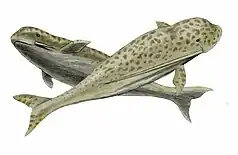Hoplocetus
Hoplocetus is an extinct genus of raptorial cetacean of the sperm whale superfamily, Physeteroidea.[3] Its remains have been found in the Miocene of Belgium, France, Germany and Malta, the Pliocene of Belgium and France, and the Pleistocene of the United Kingdom and South Carolina.[1]
| Hoplocetus | |
|---|---|
| Scientific classification | |
| Domain: | Eukaryota |
| Kingdom: | Animalia |
| Phylum: | Chordata |
| Class: | Mammalia |
| Order: | Artiodactyla |
| Infraorder: | Cetacea |
| Superfamily: | Physeteroidea |
| Family: | incertae sedis |
| Genus: | †Hoplocetus Gervais, 1852 |
| Species | |
Dentition
The teeth of Hoplocetus are massive (95–150 mm in length; 27-47 in maximum diameter), robust and have a short enamel cap on the crowns.[3] They are somewhat larger than those of modern orcas[4] but considerably smaller than those of macroraptorial sperm whales, such as Zygophyseter, as well as those of Scaldicetus caretti.[5] They display a large degree of abrasion, suggesting a highly predatory niche comparable to that of modern orcas.[3] The genus of the latter, Orcinus, first appears in the middle Pliocene and it may have eventually replaced Hoplocetus.[3]
These teeth features also characterize the other extinct toothed whale genera, Diaphorocetus, Idiorophus and Scaldicetus, sometimes placed with Hoplocetus in the subfamily Hoplocetinae.[6] However, some of these taxa are fragmentary and have been used as wastebasket taxa for non-diagnostic material of stem physeteroids.
References
- "Hoplocetus in the Paleobiology Database". Fossilworks. Retrieved 17 December 2021.
- Leidy, J. (1868). "Notice of Some Extinct Cetaceans". Proceedings of the Academy of Natural Sciences of Philadelphia. 20: 196–197. Retrieved 2018-11-12.
- Hampe, O. (2006). "Middle/late Miocene hoplocetine sperm whale remains (Odontoceti: Physeteridae) of North Germany with an emended classification of the Hoplocetinae". Fossil Record. 9 (1): 61–86. doi:10.1002/mmng.200600002.
- Bradford, A. (2014-11-20). "Orcas: Facts About Killer Whales". Live Science. Retrieved 2018-11-12.
- Reumer, J. W. F.; Mens, T. H.; Post, K. (2017). "New Finds of Giant Raptorial Sperm Whale Teeth (Cetacea, Physeteroidea) from the Westerschelde Estuary (Province of Zeeland, the Netherlands)" (PDF). Deinsea. 17: 32–38. Retrieved 2018-11-12.
- Toscano, A.; Abad, M.; Ruiz, F.; Muñiz, F.; Álvarez, G.; García, E.; Caro, J. A. (2013). "Nuevos Restos de Scaldicetus (Cetacea, Odontoceti, Physeteridae) del Mioceno Superior, Sector Occidental de la Cuenca del Guadalquivir (Sur de España)" [New Remains of Scaldicetus (Cetacea, Odontoceti, Physeteridae) from the Upper Miocene, Western Sector of the Guadalquivir Basin]. Revista Mexicana de Ciencias Geológicas (in Spanish). 30 (2).

